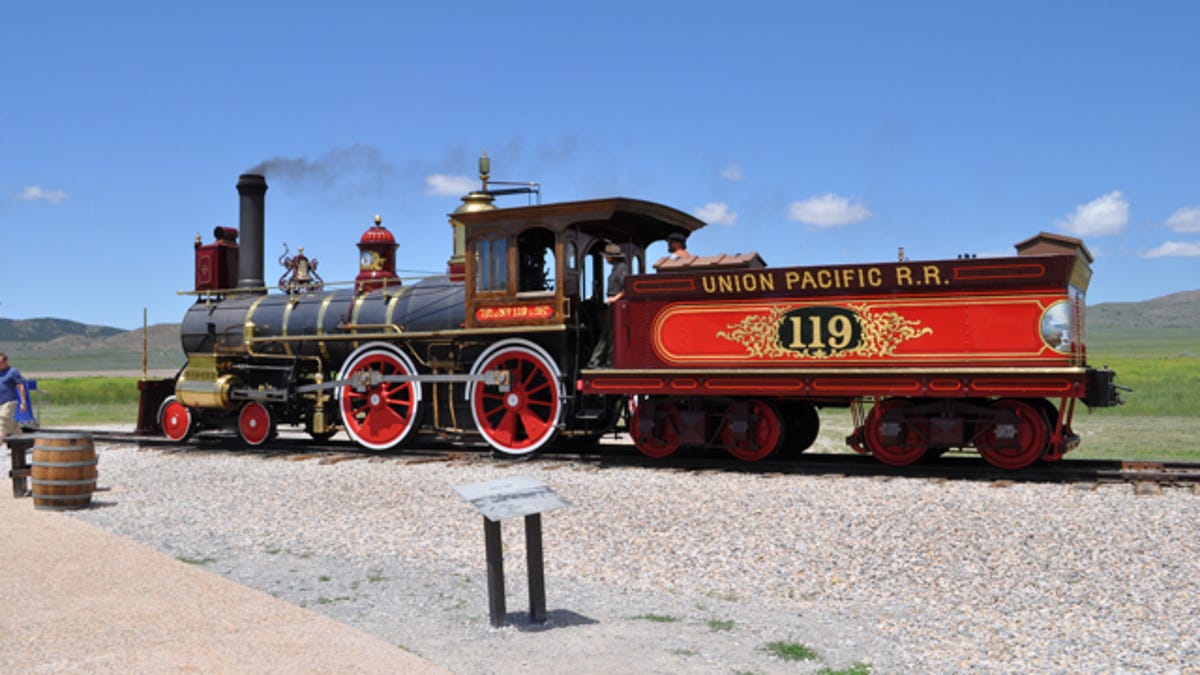Where the Transcontinental Railroad finally joined
At Promontory Summit, Utah, the Central Pacific Railroad and the Union Pacific Railroad met on May 10, 1869 after 1,776 miles of track had been laid over six years.

PROMONTORY SUMMIT, Utah--On May 10, 1869, the extraordinary happened here.
After crews from the Central Pacific Railroad had started in Sacramento, Calif., and laid 690 miles of track to the east, and teams from the Union Pacific Railroad had put down 1,086 miles of track to the west of Omaha, Neb., they met on that spring day at this spot just north of the Great Salt Lake.
They completed the Transcontinental Railroad.
For the first time, trains could traverse most of the United States. The huge event was celebrated on that day when the Central Pacific's Jupiter and the Union Pacific's No. 119 were brought nose-to-nose, with a one rail gap left in the track.
Then, as a brochure from the Golden Spike National Historic Site (see video below) puts it, "After a golden spike was symbolically tapped, a final iron spike was driven to connect the railroads."
I found the site as I was on my way to visit Spiral Jetty, the world-famous earthwork by artist Robert Smithson.
"No sooner were America's first railroads operating in the 1830s than people of vision foresaw transcontinental travel by rail," the brochure reads. "The idea gained support as a national railroad system took shape. By the beginning of the Civil War, America's eastern states were linked by 31,000 miles of rail, more than in all of Europe. None of this network, however, served the area beyond the Missouri River. Until the Great American Desert and the Rockies were bridged, the vast western territories would be a part of the nation in name only."
That was the theory behind the creation of the cross-country rail network.
In 1862, an engineer named Theodore Judah had completed a survey of a route through the Sierra Nevada and got funding from tycoons in Sacramento for his new Central Pacific Railroad, the National Park Service writes. The same year, Congress gave its approval for the Central Pacific to build east and at the same time, created the Union Pacific in New York.
Work began in 1863, with the western crews battling the mountains and the eastern crews having to fight off attacks by the Sioux and the Cheyenne. But they pushed on, using eight full flatcars of material for each mile of track.
And as the crews approached the final meeting point in Utah, they began to compete to see who could lay more daily track. They had been putting down no more than 5 miles per day. But in April 1869, the Central Pacific won a $10,000 bet by laying 10 full miles in a single day, outpacing the Union Pacific's record of 8 miles.
For the next several weeks, Geek Gestalt will be on Road Trip 2009. After driving more than 12,000 miles in the Pacific Northwest, the Southwest and the Southeast over the last three years, I'll be writing about and photographing the best in technology, science, military, nature, aviation and more in Utah, Idaho, Wyoming, Montana, South Dakota and Colorado. If you have a suggestion for someplace to visit, drop me a line. And in the meantime, join the Road Trip 2009 Facebook page and follow my Twitter feed.

